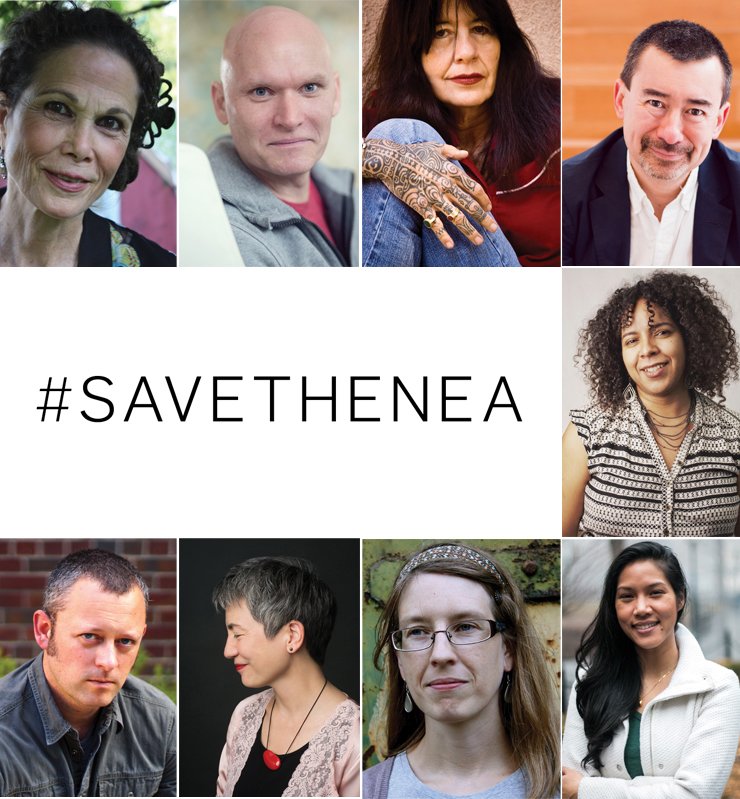Update: May 23, 2017. The Trump administration today released its first full budget proposal for Fiscal Year 2018 (running from October 1, 2017, through September 30, 2018). The $4.1 trillion budget is notable for its cuts to domestic programs focused on social welfare programs, science and research, and the arts, including the elimination of the National Endowment for the Arts (NEA), the National Endowment for the Humanities (NEH), and the Institute of Museum and Library Services, as well as the defunding of the Corporation for Public Broadcasting. Each of the proposed cuts must pass through Congress before becoming law.
Update: May 1, 2017. The House Appropriations Committee released the FY 2017 Omnibus Appropriations bill, the legislation that will provide discretionary funding for the federal government for the current fiscal year, which ends on September 30, 2017. The bill includes $150 million each for the National Endowment for the Arts (NEA) and the National Endowment for the Humanities (NEH), $2 million above the fiscal year 2016 level. Congress is expected to vote early this week on the full spending package.
During the 2016 presidential campaign, a word commonly used to describe the Republican Party’s nominee, Donald J. Trump, was nonideological. Running from outside—and to some extent against—the Republican establishment, Trump appeared ready to offer a policy agenda that would depart from his party’s traditional platforms in ways large and small.
Following his Electoral College victory over Democrat Hillary Clinton, however, President-elect Trump launched a transition during which he announced one rock-ribbed conservative appointment after another, including that of Stephen Bannon, the former executive chairman of far-right media company Breitbart News, who is committed to what he has called “the deconstruction of the administrative state,” as his chief strategist. And in the first six weeks of his administration, President Trump took a series of hard-line Republican positions: cracking down on immigrants, rolling back a slew of Obama-era regulations protecting the environment, nominating a Supreme Court justice said to be “an heir to Antonin Scalia,” reversing federal guidelines on restroom rights for transgender students, and, more recently, announcing a massive military buildup. This last increase is to be funded by deep budget cuts in other programs—including the National Endowment for the Arts (NEA), an independent agency of the federal government that offers support and funding for individuals and organizations through partnerships with state arts agencies, local leaders, other federal agencies, and the philanthropic sector.
On March 16, Trump became the first American president to propose not just cutting funds for the NEA but abolishing it outright. The White House unveiled a proposed budget that includes eliminating the NEA and its sister agency, the National Endowment for the Humanities (NEH), as well as the Corporation for Public Broadcasting, or CPB, which helps fund PBS, National Public Radio, and local public radio stations across the country.
“We are disappointed,” NEA chairman Jane Chu said in a statement, “because we see our funding actively making a difference with individuals of all ages in thousands of communities, large, small, urban and rural, and in every congressional district in the nation.”
Why kill the NEA? If the $3.9 trillion federal budget is envisioned as a pie, the Endowment’s most recent slice under President Barack Obama ($147.9 million, or .004 percent of the total) would hardly register as a crumb, much less a sliver. And yet the NEA quickly surfaces in nearly any discussion of budget cuts in the Trump era—not because gutting or killing it would contribute meaningfully to any fiscal imperative, but because many Republicans object to it on the ideological grounds that taxpayer funds shouldn’t be spent on the arts, which they consider inessential (or even “waste,” as Brian Darling, a former staffer of the Heritage Foundation, a right-wing think tank and longtime NEA opponent, put it in a recent article in the Hill, a newspaper covering politics).
“I am deeply troubled by the Trump administration’s proposed FY 2018 budget calling for the elimination of the National Endowment for the Arts,” Robert L. Lynch, president and CEO of the lobbying group Americans for the Arts, said in a statement. “Our nation’s parents, teachers, community leaders, arts advocates, government officials, and even economists will not accept this proposal.”
Although Trump has now gone further than any of his predecessors in the Oval Office, the NEA has been the target of Republican budget hawks since early in Ronald Reagan’s presidency, when David Stockman, director of the Office of Management and Budget and an architect of what became known as “supply-side” economics, planned to abolish the NEA and NEH over three years. Those plans—later confirmed in a book by Livingston Biddle, NEA chairman from 1977 to 1981—were shelved when a special task force (which included Reagan’s former Hollywood colleague Charlton Heston) concluded that the two agencies performed a valuable service to the nation. Still, and simply put, conservatives have been critical of the NEA for more than three decades because they consider it a frill.
That philosophy was carried to its logical conclusion at the state level in 2011 in Kansas, where Republican governor Sam Brownback gutted the Kansas Arts Commission by line-item-vetoing the $689,000 in state funding that would have qualified it for matching grants from the NEA and a second group. “In difficult fiscal times such as these, the state must prioritize how to spend its limited resources and focus its attention on providing core services,” Brownback said in a statement at the time. In an interview for Poets & Writers Magazine, Kansas Arts Commission chairman Henry Schwaller called it “a devastating loss.” “This has happened because of the governor’s ideological belief that public funds should not be used to fund the arts,” he said. “But it’s also related to his clear misunderstanding of the role of the arts in society and in Kansas in particular. Children and seniors, especially in rural communities, will lose access to the arts because of this.”
Cultural conservatives also still harbor an animus against the NEA that has its roots in the controversies that erupted in 1989 over photographer and NEA grantee Andres Serrano—whose “Piss Christ,” part of the artist’s Immersions series, showed a plastic crucifix submerged in what was said to be his own urine—and Robert Mapplethorpe, whose photographs depicting the gay S&M subculture were shown in an NEA-supported exhibition in Cincinnati. The Serrano and Mapplethorpe firestorms, stoked by subsequent flare-ups involving the so-called “NEA Four” (performance artists Karen Finley, John Fleck, Holly Hughes, and Tim Miller, whose grant proposals were approved by the NEA’s peer review panels but vetoed by then chairman John Frohnmayer in 1990), turned the NEA into a national lightning rod. Led by Republican senators Alfonse D’Amato of New York and Jesse Helms of North Carolina, conservatives in and out of government repeatedly called for the arts agency to be dismantled as an affront to traditional American values. “Do not dishonor our Lord,” Helms railed on the Senate floor in reference to Serrano. “I resent it, and I think the vast majority of the American people do. And I also resent the National Endowment for the Arts spending the taxpayers’ money to honor this guy.”
In recent years, controversies involving NEA-supported art have become exceedingly rare, in part because most grants to individual artists were discontinued, by congressional mandate, in 1995. The exceptions were literature fellowships and two lifetime honor programs, the NEA Jazz Masters and the NEA National Heritage Fellowships. At the same time the NEA’s advocates have successfully made the case for the arts as an economic engine, contributing $704.2 billion to the U.S. economy in 2013 alone, according to a study conducted by the NEA and the U.S. Bureau of Economic Analysis. (That includes for-profit arts activity such as filmmaking.) The NEA has also staked a claim as the nation’s most effective instigator of contributions to the arts by others. For every dollar it awards in grants, the NEA says, up to nine dollars is generated in matching support from private and public sources, leading to an additional $500 million in arts funding in 2016. Still, that onetime shibboleth of the religious right—that the NEA supports degenerate art—still bubbles up now and again on alt-right Internet forums.
Weeks before President Trump unveiled his budget plan, two powerful conservative groups—the Heritage Foundation and the Republican Study Committee, a caucus of 173 conservative Republicans in the House of Representatives—called upon him to abolish the NEA and the NEH. And the NEA remains a perennial target of right-wing media outlets such as Breitbart News, once edited by Bannon and known to be on Trump’s daily reading list. Breitbart has been publishing articles critical of the NEA at least since 2009, when it claimed the agency was encouraging artists to support President Obama’s agenda on education, health care, the environment, and other topics. “The National Endowment of the Arts is under attack—again,” poet Dana Gioia, who led the NEA from 2003 to 2009, wrote recently in an op-ed for the Los Angeles Times. “The foes are the same tired cast of characters who have assaulted the agency for the last thirty years. Their arguments are the same threadbare notions that have been repeatedly rejected. They are mounting a partisan battle that will do the nation no good. But for the sake of the arts, it needs to be fought again and won.”
Gioia continued: “Both the Heritage Foundation and the Republican Study Committee have long been obsessed with ending federal support for the arts. During my six years as the chairman of the NEA under president George W. Bush, these groups launched one unsuccessful volley after another. Their stated rationale was that the federal government had no business funding the arts. Beneath that small-government ideal, however, was another openly acknowledged motive not related to the public good but to political advantage. By eliminating the NEA, they could deliver a symbolic victory against leftist urban constituencies.”
For all these reasons, the NEA finds itself once again in potentially mortal danger. With Republicans now firmly in control of the executive branch and both houses of Congress, the agency’s prospects for continued survival may be dimmer than at any point in its history.
***
The NEA was established by Congress in 1965, during the Johnson administration, to “support the survival of the best of all forms that reflect the American heritage in its full range of cultural and ethnic diversity and to provide national leadership on behalf of the arts.” Over the years, the Endowment has dispensed more than $5 billion to artists and arts organizations in the fields of dance, design, folk and traditional arts, literature, media arts, music, opera, multidisciplinary works, performance art, theater, and the visual arts. (Poets & Writers, Inc., the nonprofit organization that publishes this magazine, receives an annual grant that supports the magazine and the website pw.org. Poets & Writers is also a cofounder of the Literary Network, or LitNet, a coalition of sixty-eight nonprofit literary organizations that was established in 1992 as an extension of the now-defunct Coalition of Writers Organizations and in response to the freedom of expression controversies surrounding the NEA.)
In the 2016 fiscal year, more than 80 percent of the NEA’s $147.9 million appropriation was distributed as grants and awards to organizations and individuals across the country. About 40 percent of that money was awarded directly to the states through their arts agencies. The other 60 percent was distributed to artists and arts organizations applying through the NEA funding categories.
In a clear response to past criticism of its grant-making process as “elitist,” the NEA now earmarks a portion of its grants for underserved communities. Forty percent of NEA-supported activities happen in neighborhoods with high poverty rates, and 36 percent of NEA grants go to organizations that reach people with disabilities, people in institutions (including prisons), and veterans. One-third of NEA grants serve audiences with low incomes.
And while some have charged that the NEA favors large cultural institutions that would more appropriately be funded by their presumably wealthy patrons, the majority of NEA grants—65 percent—go to small and medium-sized organizations in every congressional district in the nation.
All grant applications to the NEA are reviewed on the basis of “artistic excellence and artistic merit,” according to “Art Works for America,” the NEA’s 2014–2018 strategic plan. Applications are first evaluated by independent panels consisting of experts in the various disciplines and “at least one knowledgeable layperson.” The panels’ recommendations are forwarded to the NEA’s advisory body, the National Council on the Arts, whose members are artists, scholars, and arts patrons appointed by the president. The council’s recommendations are sent to the NEA chairman (currently Jane Chu, a holdover from the Obama administration), who makes the final decision.
But will there be any grant decisions to be made in the new fiscal year? Will there be a National Endowment for the Arts at all? As of this writing, it’s unclear how Trump’s budget will fare in Congress, where the NEA still enjoys the support of most Democrats and some Republicans, including moderates and even some conservatives. In his statement, Lynch quotes North Carolina Republican representative Mark Walker, chairman of the Republican Study Committee, as saying he opposes Trump’s plans for the arts: “I appreciate the education that is found in the arts, so at this point I have no path to making any kind of hard cuts right now.” In her statement, Chu implied that anything could still happen. “We understand that the president’s budget request is a first step in a very long budget process,” she said. “As part of that process we are working with the Office of Management and Budget (OMB) to prepare information they have requested.”
A message posted to the grant application page of the NEA’s website on the same day the president’s proposal was unveiled reads, “We continue to make FY 2017 grant awards and will continue to honor all obligated grant funds made to date. In addition, we will continue to accept grant applications for FY 2018 at our usual deadlines…. The agency continues to operate as usual and will do so until a new budget is enacted by Congress.”
In the coming months the House and Senate budget committees will each write and vote on budget resolutions, at which point the subcommittee’s “markup” appropriation bills determine the level of spending for all discretionary programs. Then the full House and Senate debate and vote on those bills; only after each bill passes Congress can the president sign them and the budget becomes law.
Whatever happens during this process, it won’t occur under the radar. It will be done in the full glare of the public eye, and under the careful scrutiny of those who benefit from NEA’s support, including members of the literary community who stand ready to protect the future of arts funding.
Kevin Nance is a contributing editor of Poets & Writers Magazine.













